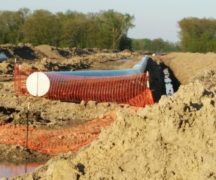By JAN LARSON McLAUGHLIN
BG Independent News
From the very start, local township trustees suspected the promise of millions of dollars from Rover pipeline into their township coffers was too good to be true.
Pipe dreams.
More than three years ago, officials from Rover pipeline met with county and township officials to explain the windfall they would be receiving from the double pipeline being constructed across the southern five townships of Wood County – Bloom, Henry, Jackson, Milton and Perry.
All of the townships were promised at least $1 million a year. Two of them – Bloom and Henry townships – were promised as much as $3 million a year.
The real numbers have now been reported by the Wood County Auditor’s Office.
Rather than $3 million a year, Henry Township will get $143,245 this next year. That amount is expected to double next year when the second Rover pipeline goes into operation. That means about $286,000 for the township – a far cry from the original estimate from pipeline officials.
In 2015, when the initial promise was made by Energy Transfer which constructed the Rover pipeline, then Wood County Auditor Michael Sibbersen questioned the estimates.
Current Wood County Auditor Matthew Oestreich shared those concerns about inaccurate estimates being given to township officials.
“I was skeptical for sure. Absolutely,” Oestreich said on Monday.
“They were throwing around some rather large numbers,” Oestreich said. “I don’t think they understood Ohio taxation at all.”
In 2015, Sibbersen said his office had to work with limited information, since the company would not provide the estimated value it used for the pipeline in its own estimates of total tax revenues.
Also in 2015, Jackson Township Trustee Brendyn George demanded answers and said residents believed the townships are in for a windfall – over $1 million for his township, according to Energy Transfer.
Henry Township Trustee John Stewart said Monday that his township also didn’t put much faith in those initial numbers.
“At that point, they didn’t understand,” Stewart said of the pipeline officials.
Townships operate on small budgets, and most trustees know better than to bank on big promises.
“We don’t depend on that,” Stewart said.
“Whatever we get is a plus. It will be invested in the roads,” he said. “I’m just happy we’re getting something for it.”
Stewart said Rover pipeline officials repaired most of the Henry Township roads torn up for the pipeline construction – but two remain in bad shape.
“We’ve been promised a lot and still haven’t received it,” he said. Energy Transfer officials have said the repairs will be made next spring.
A call by BG Independent News to Rover pipeline’s media relations office on Monday about the inaccurate tax estimates was not returned.
The company officials failed to explain that the tax revenue generated annually would be divided up among many entities – townships, schools, libraries, many county departments with existing tax levies, plus the county general fund.
Not only was the dispersal of the funding not explained, but the total tax revenue generated by the pipeline company is also shy of its original estimate of $10 million a year. Once the side-by-side pipelines are both operational, the more recent figures show they will generate $8.4 million in tax revenue a year.
A letter sent out earlier this month from Oestreich informed local governmental entities of the more realistic dollar amounts to come from the Rover pipeline. The numbers are the annual tax revenue for each entity based on the 2018 preliminary assessment certified to the county auditor’s office by the Ohio Department of Taxation.
Oestreich cautioned that the numbers may not stand.
“It is important to remember that these values will be subject to possible appeal by the pipeline company to Ohio’s Department of Taxation Public Utility division. That appeal can be made within 60 days,” he stated.
Some pipeline companies appeal the valuation to try to reduce their taxes.
“But the value is based on the figures they give the Ohio Department of Taxation,” Oestreich said. “It’s kind of ironic.”
The first tax revenue from the pipeline will be received in February of 2019. Following is a list of the preliminary annual revenue going to each entity:
Schools: $2,741,307 total
- Elmwood: $1,239,964.
- North Baltimore: $444,323.
- McComb: $40,569.
- Bowling Green: $836,594.
- Penta: $179,855.
Townships: $445,039 total
- Bloom: $109,599.
- Henry: 143,245.
- Jackson: $61,544.
- Milton: $77,664.
- Perry: $52,985.
Libraries: $65,565 total
- Wayne: $33,467.
- North Baltimore: $15,941.
- Wood County: $16,156.
Wood County public agencies are also in line to get tax revenue from the Rover pipeline. Next year, the following agencies will divide the nearly $1 million in Rover tax revenue:
- Wood County Park District: $57,482.
- Wood County Developmental Disabilities: $470,203.
- Wood County general fund: $135,082.
- Wood County Historical Center: $2,874.
- Wood County Human Services: $74,726.
- Wood County Alcohol, Drug Addiction and Mental Health Services: $149,453.
- Wood County Senior Citizens: $40,237.
- Wood County Health Department: $28,741.
The county auditor’s office does not yet know how much the Nexus pipeline, north of Bowling Green, will generate in tax revenue.
“We’re optimistic that will be on the rolls for the year following,” Oestreich said.
And the financial benefits from the pipelines keep flowing as long as they are in use, he added.
“Once they’re in, they just keep paying,” Oestreich said.




